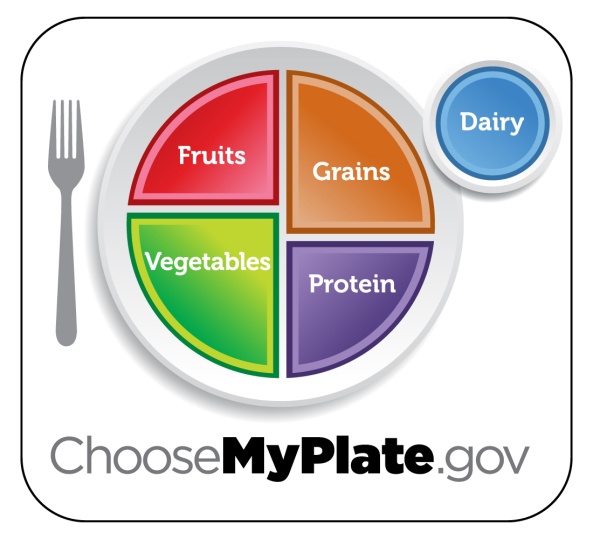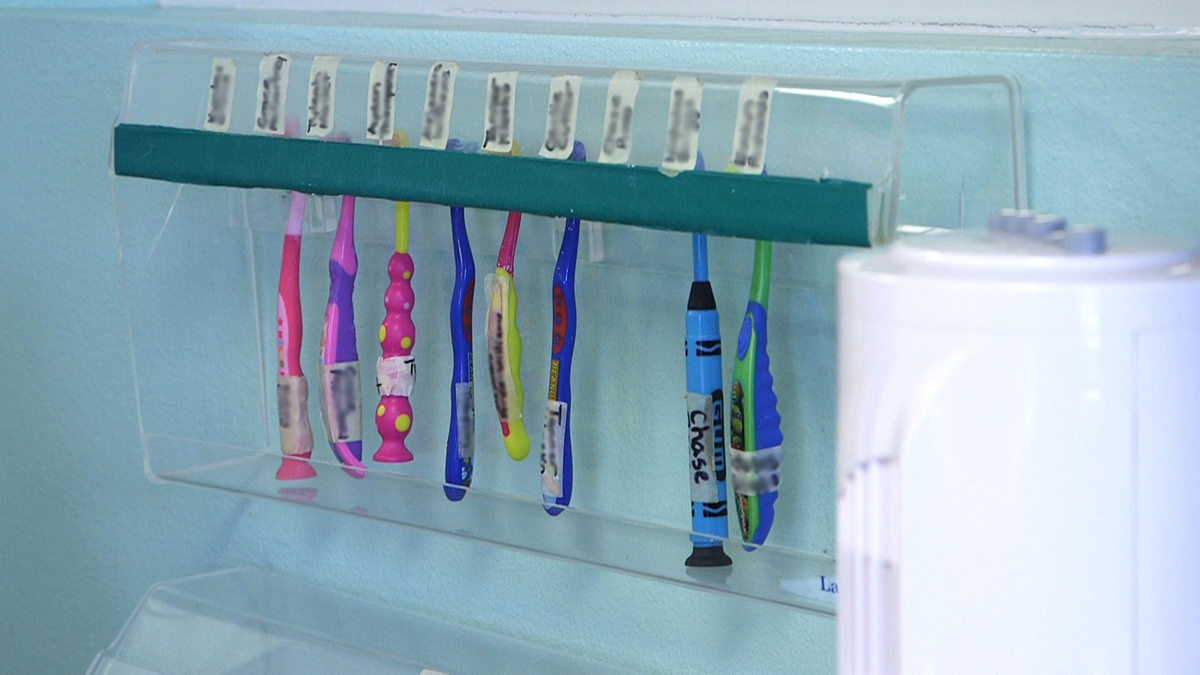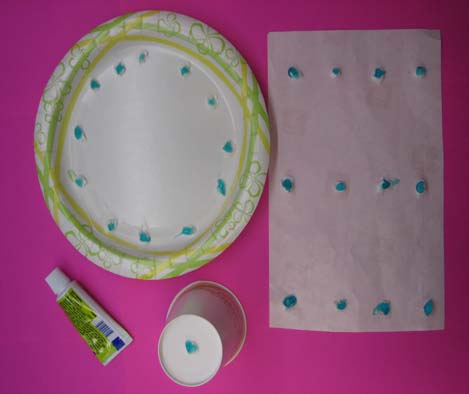- Identify tools you can use to promote healthy habits like fitness and good nutrition.
- Describe the benefits of family style dining.
- Practice and promote portion control for young children.
- Provide opportunities for active play and physical fitness.
Learn
Know
Healthy lifestyle attitudes begin early. You can help preschool children develop lifelong healthy habits. Children need you to offer healthy food choices and model a healthy lifestyle. Understanding what to eat and how much to eat are important skills for young children to learn. At the same time, understanding the importance of physical activity and how to achieve it is equally significant for young children. Establishing and maintaining healthy lifestyle attitudes ultimately affects young children's learning and reinforces the significance of the mind-body connection.
The U.S. government has developed a tool known as MyPlate to guide all of us toward healthier food choices. You can find more specific information about helping preschool children make healthy choices on their website.
Choosing What to Eat
 All of us need a variety of foods each day. A healthy diet includes a mix of grains, fruits, vegetables, dairy, and protein. The MyPlate guide helps you visualize the relative amounts of food you-and children-need each day. Half your plate should be covered with fruits and vegetables. The other half is split between grains and protein. Filling the plate with this balance of food will help children develop healthy habits from the very beginning.
All of us need a variety of foods each day. A healthy diet includes a mix of grains, fruits, vegetables, dairy, and protein. The MyPlate guide helps you visualize the relative amounts of food you-and children-need each day. Half your plate should be covered with fruits and vegetables. The other half is split between grains and protein. Filling the plate with this balance of food will help children develop healthy habits from the very beginning.
Choosing How Much to Eat
In addition to thinking about what types of food to eat, it's also important to think about how much food to eat. With obesity on the rise, portion control is an essential skill to teach young children. In addition to specific dietary needs, each person needs a certain balance of calories each day to stay healthy. Preschool children need approximately 1,200 calories per day, split between the five food groups on MyPlate. This daily food plan for a preschool-age child, based on the MyPlan guidelines, shows how much of each kind of food a preschooler needs:
Daily Food Checklist
Food Group | 2 yrs | 3 yrs | 4 & 5 yrs | Examples |
|---|---|---|---|---|
Fruitsfocus on whole fruits | 1 cup | 1 - 1.5 cups | 1 - 1.5 cups | What counts as 1/2 cup of fruit?
|
Vegetablesvary your veggies | 1 cup | 1 - 1.5 cups | 1.5 - 2 cups | What counts as 1/2 cup of veggies?
|
Grainsmake half your grains whole grains | 3 ounces | 3 - 5 ounces | 4 - 5 ounces | What counts as 1 ounce of grains?
|
Protein Foodsvary your protein routine | 2 ounces | 2 - 4 ounces | 3 - 5 ounces | What counts as 1 ounce of protein foods?
|
Dairychoose low-fat or fat-free milk or yogurt | 2 cups | 2 - 2.5 cups | 2.5 cups | What counts as 1/2 cup of dairy?
|
This is an adapted excerpt from the full document found on choosemyplate.gov
This food plan provides suggestions for a full day's worth of food. Child care programs can also look to the U.S. Department of Agriculture's Child and Adult Care Food Program for nutritional information related to each meal. You will find the recommended daily servings of each food group for breakfast, snack, and lunch attached.
Tips to Encourage Portion Control
Portion control in family style dining can be a challenge. The hallmark of family style dining is that children make choices about what they eat. There are bound to be times when children take too much or too little, spill, or refuse a particular food. This is part of the process; remember to respond patiently. To prevent many of these problems you can:
- Use small, child-sized pitchers and serving dishes.
- Limit waste by only putting a portion of available food in the serving dishes; refill as needed.
- Use child-size plates, bowls, and cups; this will help children limit themselves to healthy portions.
- Remember that children's appetites and tastes change over time; growth spurts happen throughout the preschool years.
- Encourage children to put a small serving of each available food on their plates, but do not require children to eat a certain food or a certain amount of food.
- Model adventurous eating; try each food item yourself even if you know you don't like it.
- For children who need strict portion control for health reasons, teach them how much of each item to take and monitor their eating.
- In an open-snack environment, you can also provide a picture and/or words about what one serving of today’s snack looks like (e.g., one apple, 1 large graham cracker square, and 1 cup of milk), so children know the appropriate amount to take. You can check back in with those who may need more.
- Allow second helpings of nutritious foods.
Family Style Dining
Family style dining is considered best practice when eating with preschoolers. It involves sitting at the same table with preschoolers, in small groups, with the children serving themselves when possible, and eating together with adults while sharing pleasant conversation. People pass food to one another from serving dishes. It is different from cafeteria style dining, in which children wait in line and are given single servings of food.
Family style dining has many benefits in the preschool classroom:
- It promotes social skills. Children learn to say, "please" and "thank you." They learn to ask for what they need, wait patiently, and take turns.
- It promotes language and vocabulary development. Children learn the names of new foods, and adults can model complex language around the size, color, texture, taste, and smell of foods. Meals are also a natural time for conversations about interests and ideas.
- It promotes hand-eye coordination as children handle dishes and utensils.
- It promotes decision-making and problem solving as children decide what to eat, how much to eat, and how to express their wants and needs.
- It allows children to see adults making healthy choices. This is an excellent opportunity for you to model these important lifelong behaviors.
There may be times when you have a child or children with food allergies in your classroom. It is crucial to keep those children healthy and safe. Food allergies are addressed later in this course in Lesson Seven, Special Health Needs and also in Lesson Seven in the Focused Topics course, Essentials in Child Care Food Service, Pathogens and Allergens.
What Does a Program That Promotes Healthy Eating Look Like?
Family style dining is one way programs promote healthy habits. Watch this video to see examples of high-quality family style dining. Do you use these techniques in your classroom?
Family Style Dining
Physical Activity
You can help children develop lifelong healthy habits. Physical activity is a critical component of children’s development and overall well-being. It promotes a healthy lifestyle and prevents obesity. In this lesson, think of physical activity as one more way to model healthy habits. Children learn from the adults around them, so teach them the importance of physical activity. The information you share with parents and guardians is valuable. When parents make an effort to improve or maintain their good health, those benefits are strongly related to their children's good health (Murphey et al., 2018).
In preschool programs, there are two main ways to promote physical activity: offer daily opportunities for outdoor play, and model or encourage exercise indoors and outdoors. All preschool children should have at least two or three chances to play outdoors each day, weather permitting (Caring for our Children, 2019). To help children become and remain active outside, be sure to include a few adult-led games or activities that last about five minutes. The total time a preschooler spends outdoors each day should be at least 60 to 90 minutes. However, preschool children do not need to be engaged in vigorous physical activities for the full 60 to 90 minutes to get the most health benefits. Children can get health benefits from very short or moderate bursts of activity. These short bursts add up over the day.
It is equally important to promote physical activity in the classroom as well. Music and movement is a great way to incorporate physical activity indoors and allows children opportunities to express themselves and have fun with their peers.
See
Programs that model healthy habits also promote physical activity. Watch this video to see the many ways you can help children become and stay physically fit.
Physical Fitness
Do
Safety Considerations for Meals
Safety is very important during meal times. The risk of choking is high and although requiring children to sit while eating minimizes the risk, it cannot be completely eliminated. Certain foods are known choking hazards and should not be served or on posted menus. For example, children under 4 years old should not be given:
- Hot dogs (whole or sliced into rounds)
- Whole grapes
- Raw peas and carrot rounds
- Hard candy
- Nuts, seeds
- Hard pretzels, chips, peanuts, or popcorn
- Rice cakes
- Marshmallows
- Spoonfuls of peanut butter
- Chunks of meat larger than what can be swallowed whole
Regardless of the child's age, watch to make sure they take reasonably sized bites. Intervene if a child stuffs their mouth or takes an overly large bite. Preschool children are typically able to cut or break apart their own food, but be prepared to assist a child who is having trouble.
Promoting Oral Health
 After meals, it is important to encourage children to brush their teeth. Good oral health is associated with improved overall health. Make sure each child has their own toothbrush. Store toothbrushes so they do not touch each other and can air dry. Teach children proper brushing techniques.
After meals, it is important to encourage children to brush their teeth. Good oral health is associated with improved overall health. Make sure each child has their own toothbrush. Store toothbrushes so they do not touch each other and can air dry. Teach children proper brushing techniques.
For storing toothbrushes, you can talk with your administrator about purchasing a toothbrush holder from a childcare supply company, like the one pictured above.
 You also want to prevent cross contamination of germs by dispensing smears or pea-sized amounts of toothpaste onto a large piece of wax paper, a paper plate, or bottom of a rinsing cup, and then onto each child's brush.
You also want to prevent cross contamination of germs by dispensing smears or pea-sized amounts of toothpaste onto a large piece of wax paper, a paper plate, or bottom of a rinsing cup, and then onto each child's brush.
Encourage Physical Activity
To make sure children stay safe and healthy outdoors, follow these precautions:
- Make sure each child is dressed for the weather. Encourage parents to dress children in layers that can be easily removed if needed.
- Have extra clean mittens, jackets, and hats available for children who do not have appropriate clothing.
- Make sure all the clothing a child is wearing is dry.
- Offer shaded and sheltered areas outdoors.
- Use sun protection on sunny days. Make sure children wear protective clothing and child sunscreen with SPF 15 or greater.
- Make sure water is always available.
The best way to help children be physically active is to be physically active yourself. Sitting down on the playground sets a poor example for the children (and it limits your ability to supervise effectively). Instead of sitting or standing still while children play, take an active role. Of course, your first priority is to ensure safety and adequate supervision. When you can do so safely, join in. Here are some ideas:
- Suggest a game of Ring Around the Rosie, Mother May I, or Red Rover, or a walk around the playground.
- Bring music outside and dance.
- Offer toys like jump ropes, balance beams, and balls.
- Make sure you are dressed for the occasion; wear sensible shoes and clothing.
- Encourage children's activities by recognizing their efforts. Try noticing and commenting positively when children run, throw, jump, dance, or participate in other vigorous physical activities.
Explore
In Exploring Nutrition & Physical Activity, you will explore different websites that pertain to nutrition and exercise. Review the different websites to create activities and explore information that you can share with the children and families that you serve. Share your responses with your trainer, coach, or administrator.
Taking care of your own fitness is an important way to model healthy habits for young children. It can be difficult to squeeze in physical activity during the day. Use the Activity Planner from the U.S. Department of Health and Human Services to help you set goals, choose activities you want to do, and give you tips to help stay motivated. When you are done, print your plan to track activity throughout the week.
Apply
Transitions are a great time to incorporate movement activities that support physical activity and positive behaviors. Use the Physical Activity Idea Cards during transitions by randomly selecting a card and encouraging children to do the movement. Post the Choose Your Family’s Healthy Adventure! poster on your classroom’s parent communication board to encourage healthy eating and physical activity.
Glossary
Demonstrate
American Academy of Pediatrics. (2006). A parent’s guide to childhood obesity: A roadmap to
health. S. Hassink [Ed.]
American Academy of Pediatrics. (2019). Caring for our children, national health and safety performance standards. American Academy of Pediatrics. http://nrckids.org/CFOC/Database/3.2.1.4 & http://nrckids.org
American Academy of Pediatrics. (2016). Feeding & nutrition tips: https://www.healthychildren.org/English/ages-stages/preschool/nutrition-fitness/Pages/Feeding-and-Nutrition-Your-4-to-5-Year-Old.aspx
Bright Futures. (2020). Physical activity. https://brightfutures.aap.org/Bright%20Futures%20Documents/BF4_PhysicalActivity.pdf#search=Physical%20Activity
Child Care Aware. (2020). Health Resources and Links. https://www.childcareaware.org/our-issues/health-nutrition/health-resources-and-links/
Head Start, Office of the Administration for Children and Families, Early Childhood Learning & Knowledge Center (n.d.). I am moving I am learning. https://eclkc.ohs.acf.hhs.gov/physical-health/article/i-am-moving-i-am-learning-imil
Institute of Child Nutrition. (2018). Child and adult care food programs (CACFP). https://theicn.org/cacfp
MacLaughlin, S. (2017). The truth about juice. Zero to Three. https://www.zerotothree.org/resources/1902-the-truth-about-juice
Murphey, D., Cook, E., Beckwith, S., & Belford, J. (2018). The health of parents and their children: A two-generation inquiry. Child Trends. https://www.childtrends.org/a-parents-health-is-one-of-the-strongest-predictors-of-a-childs-health
National Food Service Management Institute. (2012). More than mud pies: A nutrition curriculum guide for preschool children (6th ed). University of Mississippi.
National Resource Center for Health and Safety in Child Care and Early Education. (2021). 2021 Annual report: Achieving a state of healthy weight. Aurora, CO: University of Colorado Denver. http://nrckids.org/HealthyWeight
National Resource Center for Health and Safety in Child Care and Early Education. (2017). Preventing childhood obesity in early care and education programs. http://nrckids.org/CFOC/Childhood_Obesity
New York Department of Health and U.S. National Diabetest Education Program. (2005). Tips for kids: How to lower your risk for type 2 diabetes.
https://www.health.ny.gov/publications/0936.pdf
North Carolina State Extension & Community & Clinical Connections for Prevention & Health Branch, North Carolina Division of Public Health. Color me healthy: Preschoolers moving and eating healthy. http://www.colormehealthy.com
Pica, Rae. (2014) Moving and Learning: The physical activity specialists for birth through age 8. Red Leaf Press.
Penn State Extension. (2017). Promote healthy habits in child care – toothbrushing. https://extension.psu.edu/programs/betterkidcare/news/2017/promote-healthy-habits-in-child-care-2013-toothbrushing
Sanders, S. (2002). Active for life: Developmentally appropriate movement programs for young
Children. Human Kinetics Publishers.
SHAPE America Society of Health and Physical Educators. (2009). Active start: A statement of physical activity guidelines for children from birth to Age 5 (2nd ed.) https://www.shapeamerica.org/standards/guidelines/activestart.aspx
University of Mississippi National Food Service Management Institute. (n.d.). Information for child care.
University of North Carolina at Chapel Hill. (2018). NAP SACC. Nutrition and physical activity self-assessment for child care program. https://gonapsacc.org/self-assessment-materials
U.S. Department of Agriculture and U.S. Department of Health and Human Services. (2020 December). Dietary guidelines for Americans, 2020-2025. 9th Edition. DietaryGuidelines.gov
U.S Department of Health and Human Services and Office of Disease Prevention and Health
Promotion (2020). Physical activity: Current guidelines. https://health.gov/sites/default/files/2019-09/Physical_Activity_Guidelines_2nd_edition.pdf
U.S. Department of Health and Human Services (2020). Walk. Run. Dance. Play what’s your move? https://health.gov/moveyourway
U.S. Department of Agriculture Child and Adult Food Care Program. (n.d.). Child day care centers. https://www.fns.usda.gov/cacfp/child-day-care-centers
U.S. Department of Agriculture. (n.d.). Choose my plate initiative: Health and nutrition
Information for preschoolers. https://www.choosemyplate.gov/browse-by-audience/view-all-audiences/children/health-and-nutrition-information
U.S. Department of Agriculture. (2013). Two bite club for child care and preschool programs.
https://www.fns.usda.gov/tn/two-bite-club


